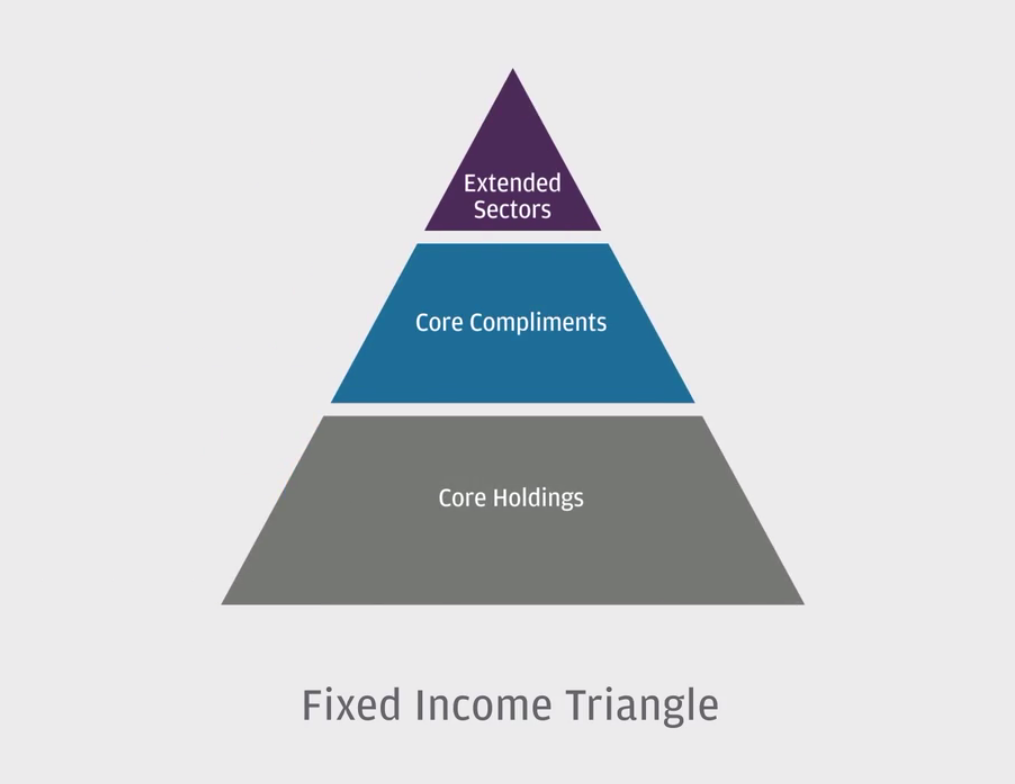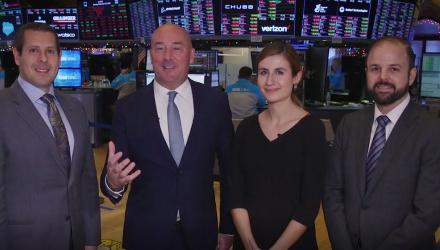After a rocky end to 2018, investors are picking themselves up in 2019, but rather than deep-diving into the capital markets headfirst, they’re picking their spots and deploying capital more strategically. This is the case for all asset classes, whether it’s equities or fixed income.
One of the challenging aspects advisors face with this more cautious investor is the plethora of options available, especially in the exchange-traded fund (ETF) space. Where are the opportunities in equities and bonds in ETFs given the current market landscape?
In the latest “In The Know” update, Samantha Azzarello, Global Market Strategist at JP Morgan ETFs, Douglas Yones, Head of Exchange Traded Products at the New York Stock Exchange, and Josh Rogers, Beta Specialist at JP Morgan Asset Management, discuss where these opportunities reside.
Strategic Allocation in Fixed Income
As investors found out during the fourth quarter of 2018, volatility makes for a challenging environment in the equities market, but a safe-haven move to the fixed income market also poses its own challenges. One corner of the bond market that especially saw inflows was short duration bonds, but Azzarello also feels more duration can help shore up fixed income portfolios during times of volatility.
“I think the appeal of short duration in 2018 is going to continue in 2019,” said Azzarello. “Being able to get a little bit of income on that short end of the curve—we still think that’s important. However, we’re also saying you need to have a little more duration in at least a part of the portfolio just to have a balance, just to have protection if volatility hits.
The go-to bond play for broad-based exposure is the iShares Core US Aggregate Bond ETF (NYSEArca: AGG), which tracks the investment results of the Bloomberg Barclays U.S. Aggregate Bond Index. The AGG gives bond investors general exposure to the fixed income markets, but there are times when current market conditions warrant a deconstruction of the AGG.
“I think more active within fixed income is called for, and even just more granularity,” said Azzarello. “So, I agree the Barclays AGG used to be the be all end all for the fixed income market. Not anymore. We know we can do better than that, we can have a better duration profile, we can get a bit more income and just be a little bit susceptible to market moves if we’re smarter with how we implement within fixed income.”
Fixed-Income Opportunities Overseas
A strategic allocation into fixed-income should include investors looking overseas for opportunities. While it’s tempting to simply allocate capital into the domestic bond markets, investors shouldn’t ignore the international credit markets, especially with countries like China becoming less stringent with respect to foreigners accessing their once hard-to-penetrate markets.
In addition, certain areas overseas may be earlier in their market cycles compared to the U.S. so issues like rate risk are not yet a concern. Additionally, bond markets overseas could provide more competitive yields when compares to those of the U.S. where a credit risk in a late market cycle could pose a concern.
“So home bias within equities is something that’s most investors are very aware of,” said Azzarello. “I don’t think investors are as aware of their home bias within fixed income. And it’s, it’s pretty intense so most American investors, 93% of their fixed income is domestic US. We say you need to look outside for more income and more diversification. So look abroad.”
Fixed-Income ETFs in a Changing Market
The move to bonds in 2018 was seen as a defensive move to hedge further rate risk after four increases in the federal funds rate by the central bank. Despite the Fed taking on a more dovish tone as it preaches more patience with respect to interest rate policy in 2019, investors are still opting for more exposure to fixed income.
New fixed income investors must be aware of the nuances before entering into this unique space with plentiful opportunities. With the fixed income market going through its own growing pains, investors need to know where the growth lies and how to position their portfolios to capitalize on these forthcoming changes.
“One of the biggest areas of growth really has been around fixed income,” said Yones. “Advisors are using ETF solutions for their fixed income bucket in a portfolio more than we’ve really seen ever before, and as a result, product developers are now putting more and unique strategies in an ETF wrapper that maybe historically you could only get via mutual funds.”
Accuracy of Pricing
One of the inherent benefits of an ETF is its ability to be bought and sold quickly like individual stocks. Mutual funds simply can’t be traded at the requisite speed of ETFs that short-term traders desire–especially when trading fixed income.
ETFs also provide daily disclosure so the investor knows which holdings the fund has, giving it an added layer of transparency over mutual funds. This also applies to prices where ETF investors can simply obtain accurate pricing from the exchange where the ETF trades.
“They (ETFs) provide intraday pricing,” said Yones. “You know one of the things we don’t always talk about anymore with ETFs is when the markets are volatile like we saw in the 4th quarter and people do want to express the ability to get into or out of the markets intraday, when we’re seeing intraday swings, the ETF allows for that, versus a fixed income mutual fund where you’re really just buying a NAV at the end of the day.”
At the New York Stock Exchange, the focus is on more transparency and expediency, such as the publishing of closing prices. The NYSE is using the help of mathematical algorithms so that investors and issuers alike know the exact price of an ETF at a specific time.
“Now we get an ETF and we’ve got a basket of bonds trading real time, pricing real time on our screen,” Yones said. “We know exactly what it’s worth. So a lot of times in the industry we’ll say, ‘Boy, ETFs have actually created transparency in what was really an opaque market.’”
The 2019 Value Comeback
While investors are flocking to safe haven assets like bonds, there’s still a need for products that capture the upside potential in U.S. equities. At the same time, however, there’s also a need for strategies that offer downside protection built into the product.
As a result of 2018’s bull market run, the quality factor often goes overlooked compared to growth and value, but with market volatility still a primary consideration and many investors favoring defensive sectors, quality stocks and the related ETFs are worth examining in 2019.
“Speaking of value, I would also say though that for investors who actually are looking for a true kind of play in the factors space,” said Rogers. “We’ve been talking a lot about value. It’s been beaten down pretty hard, a lot of people see the relative valuation as an opportunity going forward.”
One ETF in particular that captures the essence of value investing via quality is the JP Morgan US Quality Factor ETF (NYSEArca: JQUA), which tracks the performance of the JP Morgan US Quality Factor Index. For an overall value play, Rogers recommends investors look at the JP Morgan US Value Factor ETF (NYSEArca: JVAL), which tracks the JP Morgan US Value Factor Index.
Value in Fixed Income
When it comes to building a fixed income portfolio, Rogers cites the “Fixed Income Triangle” as an exemplary framework investors should follow in order to extract the most out of these portfolios.

“It’s three components–your core, which is kind of like the base of your triangle which gives you that correlation benefit to equities,” explained Rogers. “The middle which we call ‘Core Complements.’ That’s exactly where those ultra short duration type of strategies play. Then the top which is the extended sectors. Those are ways where you can sprinkle in a little high yield, a little emerging market debt to get a little bit more income.”
Investors can look at actively-managed funds like JP Morgan Ultra-Short Income ETF (BATS: JPST), which can serve as a flexible tool during times when rates are decreasing or rising. The floating rate component of bonds in JPST’s debt portfolio would effectively hedge against interest rate risk and capitalize on any short-term rate adjustments the Fed decides to make through in 2019.
The AGG gives bond investors general exposure to the fixed income markets, but there are times when current market conditions warrant a deconstruction of the AGG to extract maximum investor benefit–one way is through factor-based methodologies inherent in the JP Morgan US Aggregate Bond ETF (NYSEArca: JAGG).
“I think one of the key points of that, that we are seeing actually is that within the corporate part of the Barclays AGG, we have seen so much issuance in the lower end of the investment grade spectrum,” said Rogers. “Think of the BBBs–those are the issuers who might have a little trouble if rates start to rise more and they need to refinance debt.”
“We believe that using value, quality and momentum within issuer quality for corporate (bonds) can make a world of difference,” Rogers added.
To watch the entire latest “In the Know” show, click here.
